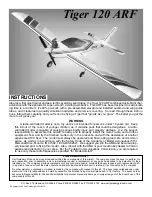
4
RADIO EQUIPMENT & CARE
There are many fine radio systems on the market. Your
local hobby dealer and club members are good sources
of information on equipment and its suitability for various
projects. It is recommended that you speak to them
before making a final choice.
Today's RC systems are very well engineered and con-
structed.
However, they
will remain only
as good as the
way in which
they are
USED. Always
follow the rules
of proper
usage and all
manufacturer's
instructions for
your particular
piece of equip-
ment.
TRANSMITTERS:
Keep your transmitter clean and free
from fuel residue and dirt. Battery condition and RF out-
put should be monitored, and the system should be
aligned and tuned annually. Do not transport under vibra-
tion (such as on the floor of a car) without cushioning.
RECEIVERS:
Receivers must be vibration free. When
installing in the aircraft, wrap them in a minimum of ¼" soft
foam rubber (not plastic foam). Keep well clear of all
cables and batteries. Tune annually (or as recommended
by the manufacturer), as indicated below under "Check-
Ups."
SERVOS:
Servos are vibration prone. Be sure to mount
them with grommet shock mounts in servo trays which are
also shock mounted. Also be sure to keep them clean. If
the neutral position "drifts," this is a sign of change which
should not be ignored; find out WHY before flying again.
BATTERIES:
Nicads also can suffer from vibration, so
they too should be wrapped in soft foam rubber before
installing. Check their condition periodically by measuring
the voltage with a volt meter or battery tester. Charge the
batteries before EVERY flying session. When not used
for a period of time (such as during the winter months) the
batteries should be charged every 30 days. Never store
batteries in a discharged condition.
PUSHRODS:
Obviously, pushrods should be installed to
operate freely, so that they place no load on the servo.
Using a servo's power to move a tight rod or heavy sur-
face by force increases the battery drain, shortens the
electronic life, and can cause neutralizing problems. In
addition, it is important the pushrods do not flex or vibrate.
Any vibration is transferred directly to the servo.
CONNECTORS:
In using connectors, never pull on the
wires to disconnect; grasp the plugs instead. Clean them
by dunking in a solvent, such as dope thinner. Tape the
connectors together when installing and make sure there
is no strain on the cables.
CHECK-UPS:
A full check-up by the factory or an author-
ized service center should be done AT LEAST ONCE A
YEAR, as well as any time something unusual occurs dur-
ing usage. A malfunction or "glitch" is the first sign of an
impending failure; it should not be ignored. The checkup
should include tuning and alignment of the system, as
well as battery testing.
ENGINE & PROPELLER SELECTION
When selecting an engine,
it is important to stay within
the manufacturer’s recommended range, as failure to
do so is likely to lead to less than satisfactory per-
formance and may well lead to failure of the aircraft.
Remember, that manufacturers design and test their mod-
els for specific engine sizes. Therefore, the aircraft is
unlikely to withstand the stresses created above this
range. Many a modeler has watched all his hours of work
and many dollars worth of hardware head earthward
because he did not heed this warning:
DO NOT OVER-
POWER YOUR MODEL!
Doing so will automatically void
the manufacturer’s warranty
.
Typically, size recommendations are for both a 2-
cycle or a 4-cycle engine. A 2-cycle engine has more raw
power because it has faster RPMs on the propeller. A 4-
cycle engine swings a bigger prop and therefore creates
more pull. It is also quieter. 4-cycle engines are general-
ly preferred for high performance, more aerobatic planes.
However, if flying a tri-gear plane, a 2-cycle should be
used. The expense of an engine is usually related to
its efficiency. Some engines of similar cubic inch
displacements are more powerful than others. Check
with a dealer or an experienced flyer to learn about the
specific attributes of the engine you are considering.
If selecting a more sophisticated engine, you may go with
the lower recommended range However, if purchasing a
more basic engine, it is probably best to select something
in the higher recommended range. If you are a relatively
new RC pilot, it's probably a good idea to select an engine
that is popular at the flying field, so that if you have any
engine problems, other modelers will be familiar with the
engine and be able to help.
REMEMBER: DON'T OVER-
POWER THE AIRCRAFT!
The propeller size must be matched to the engine. For
example, a .60 may use a 11" diameter prop while a .80
can use a 13" prop. Refer to the information that is sup-
plied with your engine for recommended propeller sizes.
It's wise to buy a few spare props, as everyone breaks
them occasionally, and particularly often when learning to
fly.
Balancing your propeller helps to protect your radio from
the damaging effects of vibration. There are good, easy
to use prop balancers on the market. Follow the instruc-
tions that are supplied with the prop balancer. Never





































